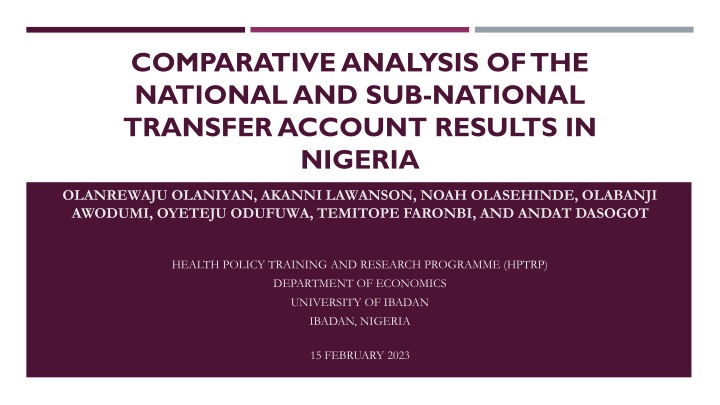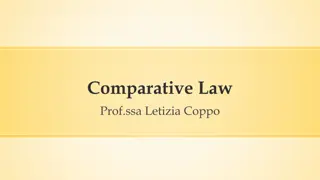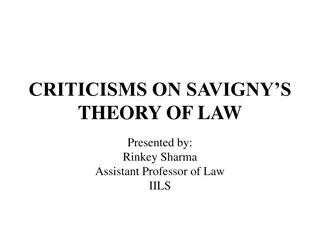
Comparative Analysis of National and Sub-National Transfer Account Results in Nigeria
Explore the comparative analysis of national and sub-national transfer account results in Nigeria, highlighting population trends and demographic patterns. Discover insights into fertility rates, mortality rates, and regional disparities in Kaduna and Lagos states. Gain valuable information on Nigeria's population pyramid and socio-economic dynamics for informed decision-making.
Download Presentation

Please find below an Image/Link to download the presentation.
The content on the website is provided AS IS for your information and personal use only. It may not be sold, licensed, or shared on other websites without obtaining consent from the author. If you encounter any issues during the download, it is possible that the publisher has removed the file from their server.
You are allowed to download the files provided on this website for personal or commercial use, subject to the condition that they are used lawfully. All files are the property of their respective owners.
The content on the website is provided AS IS for your information and personal use only. It may not be sold, licensed, or shared on other websites without obtaining consent from the author.
E N D
Presentation Transcript
COMPARATIVE ANALYSIS OF THE NATIONAL AND SUB-NATIONAL TRANSFER ACCOUNT RESULTS IN NIGERIA OLANREWAJU OLANIYAN, AKANNI LAWANSON, NOAH OLASEHINDE, OLABANJI AWODUMI, OYETEJU ODUFUWA, TEMITOPE FARONBI, AND ANDAT DASOGOT HEALTH POLICY TRAINING AND RESEARCH PROGRAMME (HPTRP) DEPARTMENT OF ECONOMICS UNIVERSITY OF IBADAN IBADAN, NIGERIA 15 FEBRUARY 2023
INTRODUCTION Comprised of six geo-political zones: 3 in the North and 3 in the South Nigeria is the most populous country inAfrica Seventh most populous country in the world with an estimated population of over 220 million With the current annual growth rate of 3.2 percent, it is projected that Nigeria will be the 3rd most populous country in the world by 2020 The population is expected to double by the year 2030 Fig(1). The rapid population growth rate attributed to the high total fertility rate (TFR) of 5.8 and low contraceptive prevalence rate of 13.4% (MICS,2016). Currently in the middle of demographic transition with fertility and mortality beginning to fall.
NIGERIA POPULATION PYRAMID The very wide base of the population pyramid is indicative of a high birth rate 85+ 80 - 84 75 - 79 70 - 74 65 - 69 60 - 64 Primarily driven by: Child/teenage marriage, low girl child education, limited use of contraceptives, and increased rate of adolescent pregnancies. The peak of the pyramid indicates that the country has a high mortality rate. 55 - 59 50 - 54 45 - 49 40 - 44 35 - 39 30 - 34 25 - 29 20 - 24 15 - 19 10 - 14 5-9 0-4 -15 -10 -5 0 5 10 15
NIGERIA POPULATION PYRAMID BY GEO-POLITICAL ZONES THE SHAPES OF THE POPULATION PYRAMIDS BY GEO-POLITICAL ZONES SHOW THAT THERE IS HIGHER FERTILITY AND MORTALITY RATES IN THE NORTHERN STATES OF THE COUNTRY. THE FERTILITY RATES IN THE SOUTHERN REGIONS ARE NOT AS HIGH AS THOSE OF THE NORTH. 75 - 79 75 - 79 75 - 79 60 - 64 60 - 64 60 - 64 45 - 49 45 - 49 45 - 49 30 - 34 30 - 34 30 - 34 15 - 19 15 - 19 15 - 19 0-4 0-4 0-4 -4.00 -2.00 0.00 2.00 4.00 -2.00 -1.00 0.00 1.00 2.00 -2.00 -1.00 0.00 1.00 2.00 80 - 84 75 - 79 75 - 79 70 - 74 60 - 64 60 - 64 60 - 64 50 - 54 45 - 49 45 - 49 40 - 44 30 - 34 30 - 34 30 - 34 20 - 24 15 - 19 15 - 19 10 - 14 0-4 0-4 0-4 -2.00 -1.00 0.00 1.00 2.00 -2.00 -1.00 0.00 1.00 2.00 -2.00 -1.00 0.00 1.00 2.00
Kaduna State POPULATION PYRAMIDS OF KADUNA AND LAGOS STATES (1950) Kaduna State: - One of the States in the North - Specifically from North West - Political headquarter of the North - Relatively predominantly youthful age - Kaduna State has a population of 8.4 million Male Female 80-84 70-74 60-64 50-54 40-44 30-34 20-24 10-14 . 0-4 -0.2 -0.15 -0.1 -0.05 0 0.05 0.1 0.15 0.2 Lagos State: - One of the state in the South - Specifically from South West - Commercial nerve centre of Nigeria - Lagos State has population of over 17 million Lagos State 80+ 70 - 74 60 - 64 50 - 54 40 - 44 30 - 34 20 - 24 10-14 0 - 4 -1.5 -1 -0.5 0 0.5 1 1.5 Male Female
Kaduna State Male Female 80-84 Kaduna State is projected to remain dominated by youthful age Lagos State low fertrility rate is already reflecting on the population dependency ratio and oppening of window of economic opportunity. 70-74 60-64 50-54 40-44 30-34 20-24 10-14 0-4 -1.5 -1 -0.5 0 0.5 1 1.5 Lagos State 80+ 70 - 74 60 - 64 50 - 54 40 - 44 30 - 34 20 - 24 POPULATION PYRAMIDS OF KADUNA AND LAGOS STATES (2050) 10-14 0 - 4 -25 -20 -15 -10 -5 0 5 10 15 20 25 Male Female
8 FERTILITY TREND IN NIGERIA, KADUNA, & LAGOS STATES (2003-2018) 7.3 7 6.4 5.9 6 5.7 5.7 Fertility is one of the major determinants of population dynamics. 5.5 5.3 5.1 5 Kaduna State is generally higher than the country s average 4.1 4 4 4 3.4 Have slowed down over the years, but still relatively high. 3 Lagos State has the least total fertility rate in Nigeria with about 3.4 livebirths per woman having dropped from 4.7 in 2011. 2 1 0 2003 2008 2013 2018 Nigeria Kaduna Lagos
PER CAPITA TOTAL EDUCATION CONSUMPTION EXPENDITURE BY AGE IN KADUNA STATE AND LAGOS STATE 25,000 20,000 15,000 Kaduna State 10,000 Similar shape, but 5,000 Relative delay in commencement of schooling in kaduna State compared with Lagos State 0 0 5 10 15 20 25 30 35 40 45 50 55 60 65 70 75 80 85 90+ 300000 Peaked at different period 250000 Lagos State 200000 Significant difference in the peak value Naira Lagos: 249,450 : Kaduna: 23,460 150000 100000 50000 0 0 2 4 6 8 1012141618202224262830323436384042444648505254565860626466687072747678808284868890 Age
PER CAPITA PROFILE OF PRIVATE CONSUMPTION OF EDUCATION FOR NIGERIA, 2016 (NAIRA) 250 200 150 Thousands 100 50 0 12 52 0 4 8 16 20 24 28 32 36 40 Educ 44 48 56 60 64 68 72 76 80 84 88
20,000 PER CAPITA PRIVATE EDUCATION CONSUMPTION EXPENDITURE BY AGE IN KADUNA STATE AND LAGOS STATE More predominant private schools at early years in lagos compared with Kaduna Significantly little spending on education takes place at primary and secondary level of education in Kaduna. Kaduna also have a larger proportion of out-of-school children compared to minimal proportion in Lagos State Avergae spending on education in Lagos State is generally far higher than what obtains in Kaduna State. 18,000 16,000 14,000 Kaduna State 10,000 12,000 8,000 6,000 4,000 2,000 0 0 5 10 15 20 25 30 35 40 45 50 55 60 65 70 75 80 85 90+ 600000 Lagos State 500000 400000 Naira 300000 200000 100000 0 0 10 20 30 40 50 60 70 80 90 Age
PER CAPITA PROFILE OF PUBLIC CONSUMPTION OF EDUCATION FOR NIGERIA, 2016 14 Thousands 12 10 8 6 4 2 0 21 30 39 48 57 0 3 6 9 12 15 18 24 27 33 36 42 45 51 54 60 63 66 69 72 75 78 81 84 87 90+ Educ
PER CAPITA PUBLIC EDUCATION CONSUMPTION EXPENDITURE BY AGE IN KADUNA STATE AND LAGOS STATE 10,000 9,000 8,000 7,000 Kaduna State 5,000 6,000 Public spending on education slao remain very low compared to Lagos State 4,000 3,000 2,000 High spending on education is consistent for a longer period of time in Lagos State compared with Kaduna State 1,000 0 0 5 10 15 20 25 30 35 40 45 50 55 60 65 70 75 80 85 90+ While Alimagiri children are common sight in Kaduna State, but an aberation in Lagos State and most Siouthern States 18000 Lagos State 16000 14000 12000 10000 Naira 8000 6000 4000 2000 0 0 10 20 30 40 50 60 70 80 90 Age
PER CAPITA PROFILE OF PRIVATE CONSUMPTION OF HEALTH FOR NIGERIA, 2016 120 100 80 Thousands 60 40 20 0 68 76 84 0 4 8 12 16 20 24 28 32 36 40 Health 44 48 52 56 60 64 72 80 88
PER CAPITA PRIVATE HEALTH CONSUMPTION EXPENDITURE IN KADUNA STATE AND LAGOS STATE Kaduna State 25,000 20,000 Consistently increased over the year in Lagos until age 82 pears, whereas the decline in Kaduna State commenced about 10 years earlier with some fluctuation in the preceding decade. 15,000 10,000 Private spending on health is generally far huge in Lagos State than in Kaduna State. 5,000 0 This is supported by stronger economic furtune in Lagos, which has the highest per capita income in the country Lagos State 350000 82 300000 250000 200000 Naira 150000 100000 50000 0 0 10 20 30 40 50 60 70 80 90 Age
PER CAPITA PROFILE OF PUBLIC CONSUMPTION OF HEALTH FOR NIGERIA, 2016 4.5 Thousands 4 3.5 3 2.5 2 1.5 1 0.5 0 3 0 6 9 12 15 18 21 24 27 30 33 36 39 42 45 48 51 54 57 60 63 66 69 72 75 78 81 84 87 90+ Health
4,500 Kaduna State PER CAPITA PUBLIC HEALTH CONSUMPTION EXPENDITURE IN KADUNA STATE AND LAGOS STATE 4,000 3,500 3,000 2,500 2,000 6000 1,500 Lagos State 68 5000 1,000 500 4000 0 Naira 3000 0 5 10 15 20 25 30 35 40 45 50 55 60 65 70 75 80 85 90+ 2000 1000 0 0 10 20 30 40 50 60 70 80 90 Age Public Public spending on health on average is relatively higher in Lagos Kaduna State reached the peak earlier, though they both started to decline at older ages
PER CAPITA TOTAL HEALTH CONSUMPTION EXPENDITURE IN KADUNA STATE AND LAGOS STATE 18,000 16,000 14,000 Kaduna State 10,000 12,000 Total spending on health on average is relatively higher in Lagos 8,000 6,000 4,000 2,000 Kaduna State reached the peak earlier, though they both started to decline at older ages 0 10 15 20 25 30 35 40 45 50 55 60 65 70 75 80 85 0 5 90+ The peak for Kaduna is #16,000, while for Lagos State is #323,000 350000 Amount (naira) 82 Lagos State 300000 250000 200000 150000 100000 50000 0 0 4 8 1216202428323640444852566064687276808488 Age
PER CAPITA AGE DISTRIBUTION OF CONSUMPTION & LABOUR INCOME FOR NIGERIA, 2016 (NAIRA) 1200 1000 800 600 400 200 0 0 2 4 6 8 10 12 14 16 18 20 22 24 26 28 30 32 34 36 38 40 42 44 46 48 50 52 54 56 58 60 62 64 66 68 70 72 74 76 78 80 82 84 86 88 90+ Consumption Labour Income
PER CAPITA AGE DISTRIBUTION OF CONSUMPTION & LABOUR INCOME FOR NIGERIA, 2016 (NAIRA) 1200 Thousands 1000 800 600 . 400 200 0 0 4 8 12 16 20 24 Consumption 28 32 36 40 44 Labour Income 48 52 56 60 64 68 72 76 80 84 88
PER CAPITA AGE DISTRIBUTION OF CONSUMPTION & LABOUR INCOME FOR KADUNA AND LAGOS STATES 600,000 500,000 Labour income appears to start earlier in Kaduna State, indicating presence of child labour 400,000 Kaduna State 300,000 While appreciable labour income has began from age 4-5years in Kaduna State, this does not show up until around 12years in Lagos State 200,000 100,000 The labour income is generally higher over the age profile for Lagos State compared to Kaduna State 0 0 5 10 15 20 25 30 35 40 45 50 55 60 65 70 75 80 85 90+ The peak for Lagos State is over #1.5 million, while Kaduna State peak was #525,000 Labor Income Consumption The peak of labour income in Lagos is flatter lasting for longer period relative to Kaduna State 1800.0 Lagos State 1400.0 Thousand Naira 1600.0 Lagos consumption began to flatten out earlier (27years) than in Kaduna State (30 years) 1200.0 1000.0 While Kaduna per capita consumption never reached #500,000, Lagos State went as far as #1.5million 800.0 600.0 400.0 Surplus life cycle was reached earlier in Kaduna State (36 years) compared to Lagos State (39years) 200.0 0.0 12 15 18 21 24 27 30 33 36 39 42 45 48 51 54 57 60 63 66 69 72 75 78 81 84 87 0 3 6 9 90+ Though labour income is comparatively higher in Lagos State, the high consumption appears to limit the surplus generated in the State and the lenght of time for which it lasted. Age Consumption Labour Income
COMPARISON OF ECONOMIC LIFECYCLE FOR SELECTED INDICATORS IN KADUNA STATE, LAGOS STATES AND NIGERIA Kaduna State Lagos State Nigeria Age lifecycle surplus started 36 39 29 Age lifecycle surplus ended 58 56 62 Length of year for lifecycle surplus 23 18 33 . Total Surplus ( Billion) Total Child Deficit ( Billion) 1.4 1.03 1.3 26.04 13.7 43.93 Total Old Age Deficit ( Billion) 41.04 30.12 1.63
PER CAPITA LIFECYCLE DEFICIT FOR NIGERIA, 2016 (NAIRA) 800 600 400 200 0 10 12 14 16 18 20 22 24 26 28 30 32 34 36 38 40 42 44 46 48 50 52 54 56 58 60 62 64 66 68 70 72 74 76 78 80 82 84 86 88 0 2 4 6 8 90+ -200 -400 -600
AGGREGATE ECONOMIC LIFECYCLE PROFILE FOR NIGERIA, 2016 (NAIRA) 2500 Billions 2000 1500 1000 . 500 0 0 2 4 6 8 10 12 14 16 18 20 22 24 26 28 30 32 34 36 38 40 42 44 46 48 50 52 54 56 58 60 62 64 66 68 70 72 74 76 78 80 82 84 86 88 90+ -500 -1000
AGGREGATE ECONOMIC LIFECYCLE PROFILE FOR KADUNA STATE AND LAGOS STATE, (NAIRA) 70,000 60,000 50,000 40,000 The aggregate life cycle deficit for Lagos State at child and old are many fold that of Kaduna State Similarly, the surplus for Lagos State is many fold that of Kaduna State, though generated for a shorter period of time. 30,000 Kaduna State (Million) 20,000 10,000 0 0 5 10 15 20 25 30 35 40 45 50 55 60 65 70 75 80 85 90+ -10,000 650 550 Lagos State (Billion) 350 450 250 150 50 0 10 20 30 40 50 60 70 80 90+ -50 Age
GROWTH RATE OF EFFECTIVE PRODUCERS, EFFECTIVE CONSUMERS, AND SUPPORT RATIO FOR NIGERIA, 1950-2050 3.50 3.00 2.50 2.00 . 1.50 1.00 0.50 0.00 1950 1952 1954 1956 1958 1960 1962 1964 1966 1968 1970 1972 1974 1976 1978 1980 1982 1984 1986 1988 1990 1992 1994 1996 1998 2000 2002 2004 2006 2008 2010 2012 2014 2016 2018 2020 2022 2024 2026 2028 2030 2032 2034 2036 2038 2040 2042 2044 2046 2048 2050 GR of EP GR of EC
GROWTH RATE OF EFFECTIVE PRODUCERS, EFFECTIVE CONSUMERS, AND SUPPORT RATIO FOR KADUNA STATE AND LAGOS STATE, 1950-2050 Figure 7.4: Growth Rates of Effective Producers and Effective Consumers in Kaduna State, 1950-2100 5.00 In Kaduna State the effective number of consumers grew faster and lay above the effective number of producers up till 1995 before it the growth of effective number of producers shifts and lay above effective number of consumers. 4.00 Growth rate of effective number of workers, 2.61 Growth rate 3.00 Kaduna State 2.00 For Lagos State Economic Support Ratio, the initial years (1955 to 1978) were marked with consistent decline. 1.00 Growth rate of effective number of consumers, 2.06 0.00 1950 1960 1970 1980 1990 2000 2010 2020 2030 2040 2050 2060 2070 2080 2090 2100 The support ratio declined from about 53 effective workers per 100 effective consumers in the early 1950s to about 44 in the effective workers per 100 effective consumers in the late 1970s and early 1980s. However, by year 2020, Lagos State support ratio has risen to 59 effective workers per 100 effective consumers, which is further projected to rise to 64 effective workers per 100 effective consumers from 2070. 4.5 4 3.5 Lagos State 2.5 Growth Rate 3 2 1.5 1 0.5 0 1950 1960 1970 1980 1990 2000 2010 2020 2030 2040 2050 2060 2070 2080 2090 2100 Year Growth rate of effective number of Producer Growth rate of effective number of Consumer
ECONOMIC SUPPORT RATIO FOR NIGERIA, 2016 0.9 0.8 0.7 0.6 0.5 . 0.4 0.3 0.2 0.1 0 1950 1954 1958 1962 1966 1970 1974 1978 1982 1986 1990 1994 1998 2002 2006 2010 2014 2022 2026 2030 2034 2038 2042 2046 2050 2018
SUPPORT RATIO FOR KADUNA STATE AND LAGOS STATE (1950-2100) 0.70 The first demographic dividend turned positive in 1995, which is the year that the window of opportunity has opened for Kaduna State. For Lagos State, the first demographic dividend became positive in 1979, representing the opening of the window of opportunity 0.65 0.60 Kaduna State 0.55 For Kaduna State, the increase positive trend will remain till year 2051 when it will reach its peak and start declining going forward. Although, it will remain positive till the turn of century. 0.50 0.45 1950 1954 1958 1962 1966 1970 1974 1978 1982 1986 1990 1994 1998 2002 2006 2010 2014 2018 2022 2026 2030 2034 2038 2042 2046 2050 2054 2058 2062 2066 2070 2074 2078 2082 2086 2090 2094 2098 The dividend for Lagos State exhibits a number of peaks observed in different years (1986, 2011, 2039, 2069). 0.7 In Lagos State, the first demographic dividend is however, reached its highest peak in 2011 where growth is raised by about 1.18 percentage point per year 0.65 Lagos State Support Ratio 0.6 0.55 0.5 0.45 0.4 1950 1960 1970 1980 1990 2000 2010 2020 2030 2040 2050 2060 2070 2080 2090 2100 Year
POLICY IMPLICATIONS Policy measure appropriate for the country may not work for the different State components alike. Harnessing demographic dividend, there has to be improvement in access and quality of education and health care services which are enablers of fertility reduction. Need for substantial investments in reproductive health and family planning is stronger for Kaduna State Education is another area to consider in investing largely on in order to reduce the high fertility rate in Kaduna State.
POLICY IMPLICATIONS KADUNA STATE: Measures to decrease fertility in the State by addressing causes of high fertility, such as: early child marriage; teenage childbearing; unmet need for FP and use of contraceptives; low literacy rate; and cultural/religious practice such as Almajiri, which exposes the children to adolescent pregnancy. access to quality education and improving girl child education are highly essential for reducing fertility and childhood mortality in Kaduna State. discouragement of child/teenage marriage and teenage pregnancies. access to reproductive health care, including low cost, safe and effective contraception Integrating family planning and safe motherhood programmes into primary health care systems. LAGOS STATE: Child mortality can be reduced in Lagos State through increase access to quality education, especially for the girl child Lagos State should promote greater access to all reproductive health care services There is need for regular studies on slums in the State to understand their diversity and put in place slum upgrade projects strategies for implementation The State Government should embark on a State migration survey with expert input through questionnaire design and strategies






















